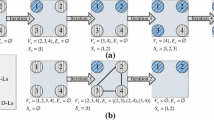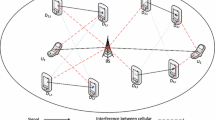Abstract
This paper presents a novel resource and power allocation scheme for device-to-device (D2D) communications overlaying cellular networks. The proposed scheme is implemented in two consecutive steps. The first step depends on implementing a vital algorithm that guarantees fairness in resource allocation among different D2D pairs by allocating the best subcarriers for every user such that every link’s data rate requirements can be satisfied. The second step utilizes the water-filling algorithm for power allocation among the subcarriers allocated to a certain link. The proposed scheme achieves high fairness with acceptable performance compared to rival algorithms in the literature. The simulation results show that the proposed algorithm outperforms the best subcarrier channel state information resource allocation scheme and the subcarrier achievable data rate scheme in terms of Jain’s fairness index.








Similar content being viewed by others
References
Fodor, G., Dahlman, E., Mildh, G., Parkvall, S., Reider, N., Miklós, G., et al. (2012). Design aspects of network assisted device-to-device communications. IEEE Communications Magazine, 50(3), 170–177.
Asadi, A., Wang, Q., & Mancuso, V. (2014). A survey on device-to-device communication in cellular networks. IEEE Communications Surveys & Tutorials, 16(4), 1801–1819.
Zhang, H., Yang, N., Long, K., Pan, M., Karagiannidis, G. K., & Leung, V. C. (2018). Secure communications in NOMA system: Subcarrier assignment and power allocation. IEEE Journal on Selected Areas in Communications, 36(7), 1441–1452.
Zhang, H., Huang, S., Jiang, C., Long, K., Leung, V. C., & Poor, H. V. (2017). Energy efficient user association and power allocation in millimeter-wave-based ultra dense networks with energy harvesting base stations. IEEE Journal on Selected Areas in Communications, 35(9), 1936–1947.
Peng, T., Lu, Q., Wang, H., Xu, S., & Wang, W. (2009). Interference avoidance mechanisms in the hybrid cellular and device-to-device systems. In 2009 IEEE 20th international symposium on personal, indoor and mobile radio communications (pp. 617–621). IEEE.
Zhang, R., Cheng, X., Yang, L., & Jiao, B. (2013). Interference-aware graph based resource sharing for device-to-device communications underlaying cellular networks. In 2013 IEEE wireless communications and networking conference (WCNC) (pp. 140–145). IEEE.
Jung, M., Hwang, K., & Choi, S. (2012). Joint mode selection and power allocation scheme for power-efficient device-to-device (d2d) communication. In 2012 IEEE 75th vehicular technology conference (VTC Spring) (pp. 1–5). IEEE.
Hakola, S., Chen, T., Lehtomaki, J., & Koskela, T. (2010). Device-to-device (d2d) communication in cellular network-performance analysis of optimum and practical communication mode selection. In 2010 IEEE wireless communications and networking conference (WCNC) (pp. 1–6). IEEE.
Cho, B., Koufos, K., & Jantti, R. (2014). Spectrum allocation and mode selection for overlay d2d using carrier sensing threshold. In 2014 9th international conference on cognitive radio oriented wireless networks and communications (CROWNCOM) (pp. 26–31). IEEE.
Pei, Y., & Liang, Y.-C. (2013). Resource allocation for device-to-device communications overlaying two-way cellular networks. IEEE Transactions on Wireless Communications, 12(7), 3611–3621.
Abrar, M., & Gui, X. (2016). Maximizing sum-rate for cellular networks with overlay d2d communication. In 2016 SAI computing conference (SAI) (pp. 919–923). IEEE.
Kai, Y., & Zhu, H. (2015). Resource allocation for multiple-pair d2d communications in cellular networks. In 2015 IEEE international conference on communications (ICC) (pp. 2955–2960). IEEE.
Jain, R., Chiu, D.-M., & Hawe, W. R. (1984). A quantitative measure of fairness and discrimination for resource allocation in shared computer system (Vol. 38). Hudson, MA: Eastern Research Laboratory, Digital Equipment Corporation.
Min, H., Lee, J., Park, S., & Hong, D. (2011). Capacity enhancement using an interference limited area for device-to-device uplink underlaying cellular networks. IEEE Trans. Wirel. Commun., 10(12), 3995–4000.
Qi, Q., Minturn, A., & Yang, Y. (2012). An efficient water-filling algorithm for power allocation in OFDM-based cognitive radio systems. In 2012 international conference on systems and informatics (ICSAI) (pp. 2069–2073). IEEE.
Jang, J., & Lee, K. B. (2003). Transmit power adaptation for multiuser OFDM systems. IEEE Journal on Selected Areas in Communications, 21(2), 171–178.
Author information
Authors and Affiliations
Corresponding author
Rights and permissions
About this article
Cite this article
Elsherief, M., Elwekeil, M. & Abd-Elnaby, M. Resource and power allocation for achieving rate fairness in D2D communications overlaying cellular networks. Wireless Netw 25, 4049–4058 (2019). https://doi.org/10.1007/s11276-018-01935-y
Published:
Issue Date:
DOI: https://doi.org/10.1007/s11276-018-01935-y




